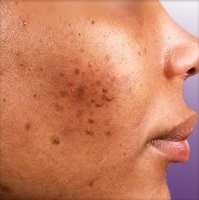BLACK SKIN AND HYPERPIGMENTATION:
For individuals with black and dark skin, hyperpigmentation manifests itself via a dappled uneven skin tone (Fig.1 & 2). This could be the result of an immune system response to inflammation, an infection and/or scarring, but it could equally be the result of daily use of topical lightening products containing substances which are banned today in cosmetics such as hydroquinone and/or dermocorticoids.

Figure 1: Hyperpigmentation spots due to acne
With the goal of reducing this dermatosis, understanding the mechanisms of melanogenesis is essential. Thus, it will be much easier for us to visualise at what level of process that we need to act, to stop and/or alleviate the activity of melanin production effectively and with no side effects.
Reminder of the melanogenesis process:
Melanogenesis takes place within the epidermis, on the uppermost layer of the skin, within specific dendritic cells known as melanocytes. These melanocytes interact with the adjacent keratinocytes to diffuse the synthesised melanin evenly. The melanogenesis process takes place within specific organelles called melanosomes, which are intrinsic to melanocytes. It is therefore the support of the synthesis of different pigments (melanins), which is responsible for our specific skin colour (phototypes).

Figure 2: Melanocyte/keratinocyte interactions
Melanocytes are capable of synthesising two non similar pigments: Pheomelanin (yellow / red carcinogen pigments) and eumelanin (brown, black photoreceptor pigments), via the same precursor: L-Tyrosine. This variation is due to the way the melanin is synthesised which implicates specific and distinct enzymes. Each individual has the two pigments, but in different proportions. It can therefore be said that the variability of pigments depends on the genetic equipment which codes for these enzymes. Caucasian skin strongly expresses the gene which codes for tyrosine, conversely to black and dark skin which express the genes coding for the two other enzymes: dopachrome tautomerase (TYRP-2) and DHICA oxidase (TYRP-1).
When melanogenesis runs riot...
Spots or hyperpigmentation are origin dependent pigmentation problems. Melanin or non melanin, widespread or localised, exclusively cutaneous or indicative of an internal illness. The dermatologist Wood Lamp examination allows for this hyperpigmentation to be accentuated so that a distinction between epidermal hyperpigmentation (accentuated by the Wood Lamp examination, possible cosmetic treatment) or dermal hyperpigmentation (fading of pigmentation under Wood Lamp) to show whether medical treatment is required.
Formation of a spot
For melanic hyperpigmentations:
- When the pigment is situated in the epidermis, the visible colour will go from light brown to black. Sometimes it is hypermelanocytosis (an increase in the number of melanocytes, like in lentigines) or hypermelanosis (increased production of melanin, like in freckles and “café-au-lait” spots).
- When the pigment is deeper and infiltrates the dermis, the lesion will have a bluish tint. Nevus of Ota and mongolic spots correspond to the activity of melanocytic cells where embryonic migration has stopped within the dermis (dermal hypermelanocytosis), whilst pigmentary incontinence for the melanocytes of the epidermis gives dermal hypermelanosis of pigmentations, post-inflammatory...
For black or dark skin, most hyperpigmentation problems are melanic in nature and relate to the epidermis. For this skin, all inflammation rapidly causes dyschromia which comes to the fore to mask or replace the basic lesion:
- In most cases this stimulates melanogenesis, thus causing hyperpigmentation
- Conversely, in rare cases, it is insufficient in comparison with the acceleration of epidermal regeneration, thus causing hypopigmentation.
Epidermal hyperpigmentation, despite it’s need for a trigger (sun, inflammation...) is due to overexpression of a key enzyme (tyrosinase in people with asian or caucasian skin). In black people, in addition to tyrosinase, a second key enzyme causes an overproduction of dark and black pigments.
This dyschromia, designated with the term “spots” constitutes 75% of the reasons for dermatological consultations in black and dark skinned people.
Treatments
The first measure is preventative. Sun exposure is consistently harmful. It aggravates all causes of pigmentation and can speed up relapse in treated areas. Exclusion of ultraviolet will therefore be strict, both during the cure as well as after. SPF 50 such as SUN'OYA® My Sun Fluid should be applied for any prolonged sun exposure. Photosensitive substances should be banned.
Hyperpigmentation treatment must act upon the initial cause, that is, on the melanogenesis enzymes, as is the case with MEL’OYA® Correcting Serum.
The treatment will rely on molecules which allow the level of melanogenesis enzymes to be maintained:
- For caucasian and asian skin (to maintain the level of tyrosinase): azelaic acids, retinoic acids (dangerous for black skin), arbutin, kojic acid, lasers...
- For indian and black skin: in addition to molecules which are able to block the level of tyrosinase, we also need molecules which are capable of blocking enzymes which are specific to these types of skin (IN’OYA system).
Current products available on the market
Currently, 60% of black women admit to having used whitening products with the goal of achieving a clearer and more uniform complexion. This commonplace practice, initiated by the media, can not only cause significant dermatological problems, but also systemic complications in the long run. Around 70% of users present with skin conditions such as acne, stretch marks or even skin dyschromia.
Products available on the market, which claim to have lightening properties are products which should only be used for therapeutic reasons. They usually contain mercury derivatives (30.9%), hydroquinone (24%) as well as corticosteroids (18.5%) and present significant side effects. Products which are appropriate for black and dark skin have been developed and tested on caucasian and asian skin, without taking into account the specific differences between the two different skin types.
At the present time, products available for black and dark skinned women are either ineffective, or dangerous for the health in normal conditions of use. It is for this reason that the IN’OYA lab was created.
That is why developing ranges of products which respond to a skin problem relating to a specific skin type is essential.
Prospects of the IN’OYA Lab
The technology used by the IN’OYA SAS Lab has been developed to respond to this growing public health problem, which is voluntary depigmentation. The goal is also to alleviate the unaesthetic aspect of localised hyperpigmentation after a particular exterior agression.
Our objective is to develop a peptide and/or natural molecule effective active ingredient that has no side effects, to incorporate within cosmetics which are adapted specifically to black and dark skin and which can finally respond to a real need.
CONCLUSION
Melanogenesis is a programmed genetic mechanism and is therefore difficult to modulate. In the case of black and dark skin, zones of localised hyperpigmentation, in the form of lasting brown spots on areas of old scarring. Current treatments available on the market are either ineffective, or dangerous for the health in normal conditions of daily use.
That’s why, in response to this voluntary depigmentation, which represents a public health issue, and to diminish the unaesthetic look of hyperpigmentation resulting from an exterior aggression, the IN’OYA Lab has made research their main activity (partners with the French National Centre of Scientific Research, INSERM, the Marseille Faculty of Pharmacy...).
In fact, our objective is to develop an effective active ingredient that has no side effects, to incorporate within cosmetic formulas which are adapted specifically to black and dark skin and which can finally respond to all skin types (oily, mixed and dry).





